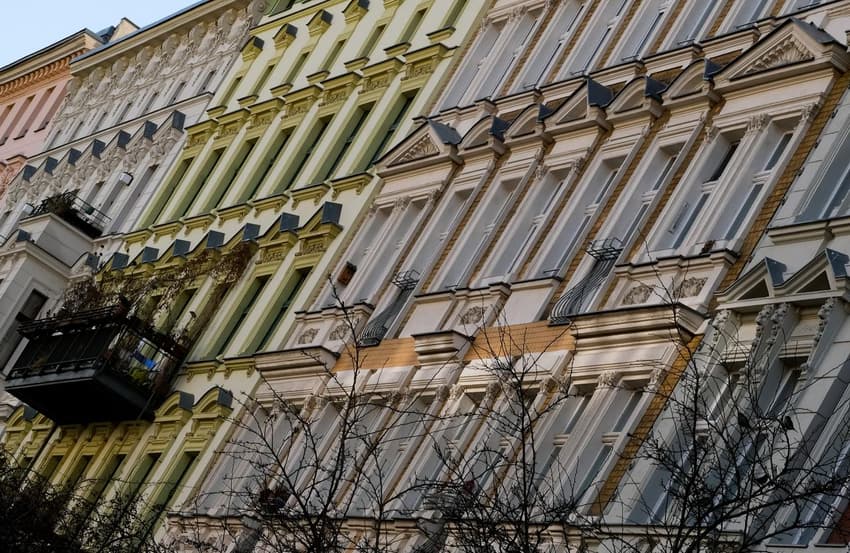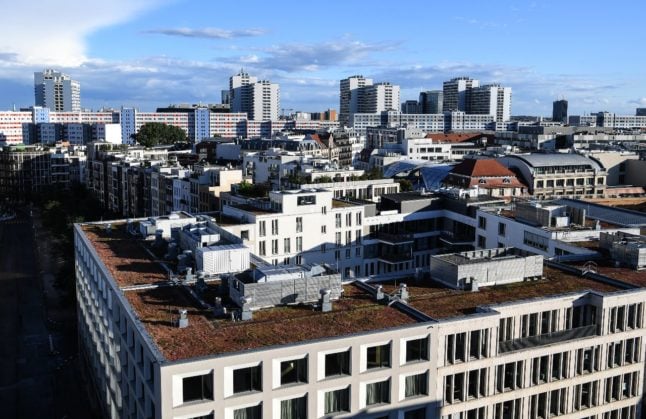EXPLAINED: How Berlin rents and property prices soared in 2022

High rents and housing shortages are nothing new in Germany's capital - but a recent report shows the trend is accelerating, with average asking rents going up by almost a euro per square metre last year.
Looking to move? Find your next rental apartment here.
Anyone who's scoured the recent listings on WG Gesucht or ImmobilienScout24 will be able to see the prices on Berlin's rental market are higher than they've ever been.
It's not unusual to see 50 square metre flats advertised for a good €1,500 per month these days - and that's without utilities - making the city's former rent cap feel like a distant memory.
The latest housing report from the Investitionsbank Berlin (IBB) translates this anecdotal evidence into facts: in 2022 alone, rents in the capital rose by around 10 percent or just under one euro to €11.54 euros per square metre.
READ ALSO: EXPLAINED: In which German cities are rent prices rising the fastest?
If that seems a little on the cheaper end, it's because it's an average taken from all districts of Berlin, from Buch or Marzahn way out in the east to Kreuzberg and Prenzlauer Berg, two of the city's more central districts.
For apartments in the city centre, asking rents shot up to around €16 per metre on average, while flats outside the Berlin S-Bahn ring came in at €9.71 per square metre. Berlin's price level is also spreading to areas just outside the city: here, IBB registered average asking rents of €11.12 last year.
One of the reasons for the steep jump in rental costs is the high level demand for living space. After dropping a little during the pandemic, Berlin's population grew again by 13,384 people in 2022, with far more people arriving from other German states or from abroad than Berliners leaving the capital. And this doesn't look set to go down, either: the Senate Department for Urban Development, Building and Housing expects Berlin's population to increase by 5 percent to 3,962,875 people by 2040.
Far too few affordable homes
As part of its study, IBB tracked the availability of homes in three different price brackets: the low price segment (under €7 per square metre), the middle price segment (€7-10) and high (€11 or above). In the most expensive category, housing supply was generally keeping up with demand - with the exception of a few districts such as Reinickendorf and Treptow-Köpenick.
However, when it came to properties in the middle category, all districts had less - or in the cases of districts like Neukölln and Kreuzberg-Friedrichshain, a lot less - housing than needed. In the bottom price segment, all districts had a drastic need for new homes.

Flats in Berlin's city centre. Photo: picture alliance/dpa/dpa-Zentralbild | Britta Pedersen
This is partly driven by low levels of construction in previous years: in 2021, the number of completed building projects declined for the second year in a row, although construction intensity remained at a high level. In the second year of the pandemic, just 15,870 new homes were completed - 467 fewer than in the previous year.
Potential reasons for this decline include the sharp rise in construction and financing costs, which has made a lot of projects far less financially viable. In addition, high interest rates have been making it trickier for companies to finance their projects in the first place.
However, with a construction backlog of around 65,000 flats and a realisation rate of approximately 87 percent, IBB expects that a large proportion of these flats will be ready for occupancy in the coming years.
READ ALSO: Germany sees record high rent increases in 2023
Purchase prices continue to rise unabated
With the steep rises in rents, people have increasingly been looking to purchase properties in the German capital, which has also led to price rises in owner-occupied homes.
According to IBB, the asking prices for flats in Berlin have more than doubled since 2012. On average, flats were offered for €5,817 per square metre, with new-build flats significantly higher at €8,409 per square metre. In 2021, Berliners had to spend an average of €698,000 to fulfil their dream of owning their own home. Most of these property purchases were flats, with detached and semi-detached houses only making up a small proportion of the properties sold in Berlin.

Blocks of flats in the German capital of Berlin. Photo: picture alliance/dpa | Florian Schuh
"The affordability of housing continues to be one of the most pressing problems for Berlin households," said IBB chairman Dr. Hinrich Holm. "The discrepancy between increasing demand and the lack of construction activity has recently led to a historic increase in asking rents. Currently, the need for housing is estimated at at least 47,000 flats."
This was largely to do with insufficient planning and construction, Holm said. "Both rent-controlled and privately financed housing construction and the activation of private developers will continue to be important for this. IBB will continue to support and promote these projects within the framework of our funding programmes in order to provide the broadest possible access to affordable housing."
READ ALSO: Why does Germany keep missing its house-building targets?
From Berlin to Brandenburg?
The search for housing within Berlin is becoming increasingly challenging due to housing shortages and rising rents, which is increasingly driving Berliners - and especially young families - out to the countryside.
The destinations for migration are Berlin's surrounding areas, but increasingly also the second-tier cities and the wider communities of Brandenburg.
These migratory movements are also increasing the volume of commuters living in Brandenburg, which has an impact on the volume of traffic and the housing market situation in the Brandenburg municipalities. The median asking rents have risen in all regions, although Berlin's inner city is by far the priciest place to live. Somewhat strangely, the asking rents in the surrounding areas just outside Berlin have exceeded those in the outer districts of Berlin since 2019.
Comments
See Also
Anyone who's scoured the recent listings on WG Gesucht or ImmobilienScout24 will be able to see the prices on Berlin's rental market are higher than they've ever been.
It's not unusual to see 50 square metre flats advertised for a good €1,500 per month these days - and that's without utilities - making the city's former rent cap feel like a distant memory.
The latest housing report from the Investitionsbank Berlin (IBB) translates this anecdotal evidence into facts: in 2022 alone, rents in the capital rose by around 10 percent or just under one euro to €11.54 euros per square metre.
READ ALSO: EXPLAINED: In which German cities are rent prices rising the fastest?
If that seems a little on the cheaper end, it's because it's an average taken from all districts of Berlin, from Buch or Marzahn way out in the east to Kreuzberg and Prenzlauer Berg, two of the city's more central districts.
For apartments in the city centre, asking rents shot up to around €16 per metre on average, while flats outside the Berlin S-Bahn ring came in at €9.71 per square metre. Berlin's price level is also spreading to areas just outside the city: here, IBB registered average asking rents of €11.12 last year.
One of the reasons for the steep jump in rental costs is the high level demand for living space. After dropping a little during the pandemic, Berlin's population grew again by 13,384 people in 2022, with far more people arriving from other German states or from abroad than Berliners leaving the capital. And this doesn't look set to go down, either: the Senate Department for Urban Development, Building and Housing expects Berlin's population to increase by 5 percent to 3,962,875 people by 2040.
Far too few affordable homes
As part of its study, IBB tracked the availability of homes in three different price brackets: the low price segment (under €7 per square metre), the middle price segment (€7-10) and high (€11 or above). In the most expensive category, housing supply was generally keeping up with demand - with the exception of a few districts such as Reinickendorf and Treptow-Köpenick.
However, when it came to properties in the middle category, all districts had less - or in the cases of districts like Neukölln and Kreuzberg-Friedrichshain, a lot less - housing than needed. In the bottom price segment, all districts had a drastic need for new homes.

This is partly driven by low levels of construction in previous years: in 2021, the number of completed building projects declined for the second year in a row, although construction intensity remained at a high level. In the second year of the pandemic, just 15,870 new homes were completed - 467 fewer than in the previous year.
Potential reasons for this decline include the sharp rise in construction and financing costs, which has made a lot of projects far less financially viable. In addition, high interest rates have been making it trickier for companies to finance their projects in the first place.
However, with a construction backlog of around 65,000 flats and a realisation rate of approximately 87 percent, IBB expects that a large proportion of these flats will be ready for occupancy in the coming years.
READ ALSO: Germany sees record high rent increases in 2023
Purchase prices continue to rise unabated
With the steep rises in rents, people have increasingly been looking to purchase properties in the German capital, which has also led to price rises in owner-occupied homes.
According to IBB, the asking prices for flats in Berlin have more than doubled since 2012. On average, flats were offered for €5,817 per square metre, with new-build flats significantly higher at €8,409 per square metre. In 2021, Berliners had to spend an average of €698,000 to fulfil their dream of owning their own home. Most of these property purchases were flats, with detached and semi-detached houses only making up a small proportion of the properties sold in Berlin.

"The affordability of housing continues to be one of the most pressing problems for Berlin households," said IBB chairman Dr. Hinrich Holm. "The discrepancy between increasing demand and the lack of construction activity has recently led to a historic increase in asking rents. Currently, the need for housing is estimated at at least 47,000 flats."
This was largely to do with insufficient planning and construction, Holm said. "Both rent-controlled and privately financed housing construction and the activation of private developers will continue to be important for this. IBB will continue to support and promote these projects within the framework of our funding programmes in order to provide the broadest possible access to affordable housing."
READ ALSO: Why does Germany keep missing its house-building targets?
From Berlin to Brandenburg?
The search for housing within Berlin is becoming increasingly challenging due to housing shortages and rising rents, which is increasingly driving Berliners - and especially young families - out to the countryside.
The destinations for migration are Berlin's surrounding areas, but increasingly also the second-tier cities and the wider communities of Brandenburg.
These migratory movements are also increasing the volume of commuters living in Brandenburg, which has an impact on the volume of traffic and the housing market situation in the Brandenburg municipalities. The median asking rents have risen in all regions, although Berlin's inner city is by far the priciest place to live. Somewhat strangely, the asking rents in the surrounding areas just outside Berlin have exceeded those in the outer districts of Berlin since 2019.
Join the conversation in our comments section below. Share your own views and experience and if you have a question or suggestion for our journalists then email us at [email protected].
Please keep comments civil, constructive and on topic – and make sure to read our terms of use before getting involved.
Please log in here to leave a comment.